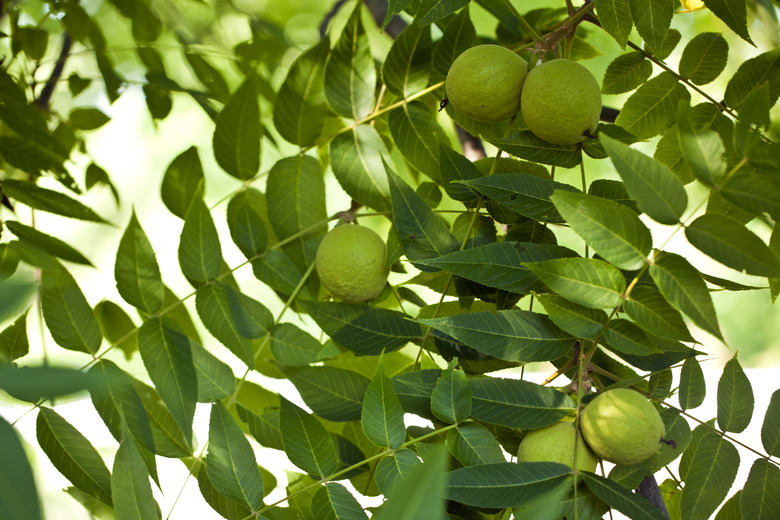How To Stop A Walnut Tree From Producing Walnuts
We may receive a commission on purchases made from links.
Towering a massive 50 feet or higher in the air and easily living for 150 years or more, walnut trees (Juglans spp.) make great shade trees and are really quite lovely. Unfortunately, they can produce large amounts of fruit late in the summer and early in the fall. A single tree produces an average of 50 to 80 pounds of nuts per year, but some years, bumper crops will produce even more. This is great news if you love walnuts and have the patience to fight through their tough outer shells and eat them.
For many people, though, the heavy, baseball-size fruits these trees produce are merely a nuisance, as they're heavy enough to dent car roofs and round enough to roll an ankle. If you love the tree but not the fruit, there are ways to try to prevent the nuts from forming. These nuts are the way the trees reproduce, however, and Mother Nature is not easily deterred. Despite your best efforts, you may only succeed in reducing the number of walnuts the tree produces rather than eliminating them altogether.
Fertilize for Leafy Growth
Fertilize for Leafy Growth
One way to discourage your walnut tree from fruiting is to fertilize it with nitrogen-only fertilizer early in the spring and late in the summer. Nitrogen promotes foliage growth in plants, often at the expense of flowering when available in excess. Overloading the tree with nitrogen should maximize leaf production while minimizing fruit production. This is a simple trick that's easy and safe to try.
Remove Other Trees
Remove Other Trees
Walnut trees can self-pollinate to a point, but they produce far more fruit when pollinated by another tree. If you have multiple walnut trees on your property, you may be able to slow your favorite one's walnut production by removing the others. Before you go this route, however, take a look around your neighborhood. You can remove your walnut trees, but this probably won't help if your neighbors have one too.
Chemical Treatment Options
Chemical Treatment Options
Mostly used in orchards to give farmers better control over fruit production, growth-regulator chemicals, like Florel brand growth regulator, can slow fruit production. Perhaps counterintuitively, these products are actually growth hormones. Flooding the plant with them can overload it and cause the death of any fruits that are forming.
These chemicals are likely your best shot at successfully stopping walnut production but use them with caution. None are listed for use on walnut trees specifically, and timing the application is critical. These chemicals work best when applied in the middle or at the end of the tree's preproduction flowering period. Apply it too late and it will have no effect. If it's too early, you may end up with even more walnuts than usual.
Remove the Tree
Remove the Tree
Unfortunately, the only way to guarantee that you won't get any walnuts is to kill the tree or remove the tree altogether. It's easy to view this as a viable option when you've just twisted your ankle again or bent another mower blade, but think twice before doing so. Walnut trees provide lots of shade and a home for squirrels and many other critters. You may also be removing a tree that's been part of your neighborhood for more than 100 years.
Get a Nut Gatherer
Get a Nut Gatherer
If you fail at preventing your tree from producing walnuts but don't want to cut it down, consider purchasing a nut gatherer. This handy device is essentially a flexible cage on the end of a handle. Simply roll the device over the ground and it will pick up walnuts, apples, and other fallen tree fruit with ease. This is a fast and easy way to clean up dropped walnuts so you and your tree can live together a little easier. You still won't want to park directly under the falling fruit, but at least you won't twist an ankle once you're out of the car.
References
- Laidback Gardener: How to Prevent a Walnut Tree From Bearing Nuts?
- University of Illinois Extension: Prevent Walnut Tree from Fruiting
- Utah State University Extension: Walnuts in the Home Orchard
- Penn Live: Walnuts Dropping All Over the Deck
- Laidback Gardener: Pick Up Nuts and Fruits Without Bending Over!
